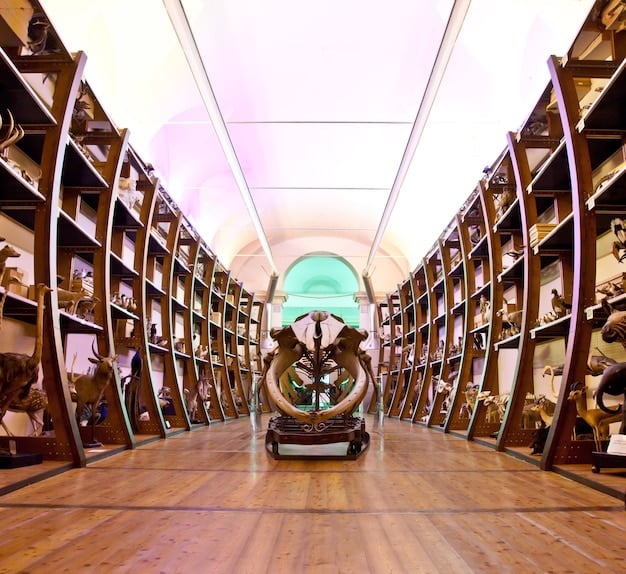Digital Humanities Impact on Literary Criticism in the US: A Deep Dive

Exploring the impact of digital humanities on literary criticism in the US unveils how computational tools, data analysis, and digital archives are reshaping the methodologies and expanding the scope of literary inquiry, leading to new interpretations and understanding of literary texts.
The integration of digital humanities into literary criticism is transforming how we approach and understand literature in the United States. This interdisciplinary field merges traditional literary analysis with computational methods, opening new avenues for research and interpretation. This article delves into exploring the impact of digital humanities on the methods and scope of literary criticism in the US.
The Rise of Digital Humanities in Literary Studies
Digital humanities has emerged as a significant force in academic disciplines, including literary studies. This field leverages computational tools and digital resources to explore, analyze, and interpret literary texts in novel ways.
Defining Digital Humanities
Digital humanities encompasses a wide range of activities, from digitizing archives to using data mining techniques to analyze large corpora of texts. It’s an interdisciplinary field that combines humanities scholarship with digital technologies.
Why Digital Humanities Matters in Literary Criticism
By providing new tools and methodologies, digital humanities enables literary critics to ask different kinds of questions and explore literary texts on a scale that was previously impossible. This leads to fresh insights and a deeper understanding of literature.

Here are some key reasons why digital humanities is important in literary criticism:
- Enhanced Analytical Capabilities: Digital tools allow for detailed analysis of patterns and trends in literary texts.
- Expanded Scope of Research: Scholars can work with much larger datasets, leading to broader conclusions.
- New Interpretations: Computational methods can reveal hidden connections and meanings in literature.
- Increased Collaboration: Digital humanities projects often involve interdisciplinary teams.
In conclusion, the rise of digital humanities signifies a paradigm shift in literary studies, offering tools and approaches that complement and extend traditional methods of literary analysis.
Data Mining and Text Analysis in Literary Research
One of the most impactful applications of digital humanities in literary criticism is the use of data mining and text analysis. These techniques allow researchers to uncover patterns, themes, and relationships within literary texts that might not be apparent through traditional reading methods.
Uncovering Patterns in Text
Data mining involves using algorithms to extract valuable insights from large datasets. In literary research, this can involve analyzing word frequencies, identifying recurring motifs, and mapping the relationships between characters or themes.
Tools for Text Analysis
Several software tools and platforms are available for text analysis, including Voyant Tools, AntConc, and more specialized applications designed for literary research. These tools provide functionalities such as concordance analysis, keyword extraction, and sentiment analysis.
Here’s how data mining and text analysis are utilized in literary research:
- Identifying Themes: By analyzing word frequencies and co-occurrences, researchers can identify dominant themes in a text.
- Mapping Character Relationships: Network analysis techniques can visualize the connections between characters in a novel or play.
- Studying Authorial Style: Analyzing the vocabulary and syntax used by an author can reveal unique stylistic features.
- Tracing Literary Influences: Comparing texts using computational methods can uncover influences and intertextual connections.
In conclusion, data mining and text analysis provide literary critics with powerful tools for exploring literary texts in a systematic and data-driven way. These methods complement traditional close reading and offer new perspectives on literary works.
Digital Archives and the Accessibility of Literary Texts
The proliferation of digital archives has revolutionized access to literary texts, making a vast array of materials available to researchers and readers worldwide. This increased accessibility has profound implications for literary criticism.
The Role of Digital Archives
Digital archives consist of digitized versions of manuscripts, letters, early editions, and other primary source materials. These archives provide access to texts that were previously difficult or impossible to access, opening up new avenues for research.
Impact on Literary Criticism
By making literary texts more accessible, digital archives enable scholars to conduct research on a broader scale and to examine texts in new contexts. They also facilitate collaborative research and promote greater inclusivity in literary studies.

Here are some key benefits of digital archives for literary criticism:
- Increased Access: Researchers can access texts from anywhere in the world, regardless of their institutional affiliation.
- Improved Searchability: Digital archives allow for keyword searching and other advanced search capabilities.
- Enhanced Preservation: Digitization helps preserve fragile or deteriorating texts for future generations.
- Facilitation of Collaboration: Digital archives enable scholars to share and annotate texts collaboratively.
In conclusion, digital archives have democratized access to literary texts and transformed the landscape of literary research. By making a wealth of materials available online, these archives empower scholars to explore literature in new and innovative ways.
Network Analysis and the Study of Literary Relationships
Network analysis, a technique borrowed from sociology and computer science, has gained traction in literary studies as a way to map the relationships between characters, themes, and ideas within and across literary texts. This approach offers a visual and quantitative perspective on literary relationships.
Applying Network Analysis to Literature
Network analysis involves representing literary elements as nodes in a network and the relationships between them as edges. By analyzing the structure of these networks, researchers can gain insights into the dynamics of literary texts.
Insights from Network Analysis
Network analysis can reveal hidden connections and patterns in literary works, such as identifying central characters, tracing the flow of ideas, and mapping the evolution of themes. This approach complements traditional interpretive methods by providing a quantitative perspective on literary relationships.
Examples of Network Analysis
Network analysis can be used to visualize character interactions in a novel, trace the circulation of ideas in a literary movement, or map the influence of one author on another. These visualizations can help researchers identify key relationships and patterns that might otherwise be overlooked.
In conclusion, network analysis offers a valuable approach for studying literary relationships, providing a visual and quantitative perspective on the complex dynamics of literary texts and traditions.
Challenges and Criticisms of Digital Humanities in Literary Criticism
While digital humanities offers many potential benefits for literary criticism, it also faces several challenges and criticisms. These include concerns about data bias, the privileging of quantitative methods over qualitative analysis, and the potential for technological determinism.
Addressing Data Bias
One concern is that the datasets used in digital humanities research may be biased, leading to skewed or inaccurate results. It is important to carefully evaluate the sources and methods used to create digital archives and text corpora to ensure that they are representative and unbiased.
Balancing Quantitative and Qualitative Methods
Another criticism is that digital humanities tends to prioritize quantitative methods over qualitative analysis. It is important to strike a balance between these two approaches, using computational tools to complement and enhance traditional close reading, rather than replacing it.
Avoiding Technological Determinism
Some critics worry that digital humanities may lead to technological determinism, the belief that technology shapes society and culture in a predetermined way. It is important to recognize that technology is a tool that can be used in different ways, and that literary critics should maintain intellectual independence and critical perspective.
In conclusion, while digital humanities offers many exciting possibilities for literary criticism, it is important to be aware of the challenges and criticisms associated with this field. By addressing these issues, literary scholars can harness the power of digital tools to deepen their understanding of literature.
The Future of Literary Criticism in the Digital Age
The integration of digital humanities into literary studies is an ongoing process, and the future of literary criticism in the digital age is likely to be shaped by new technologies, methodologies, and collaborative practices. As digital tools become more sophisticated and widely available, literary critics will have even greater opportunities to explore, analyze, and interpret literature in innovative ways.
Emerging Technologies
New technologies such as artificial intelligence, machine learning, and natural language processing are poised to transform literary criticism. These tools can be used to automate tasks such as text analysis, sentiment analysis, and topic modeling, freeing up researchers to focus on more interpretive and creative aspects of literary study.
Collaborative Practices
Digital humanities projects often involve interdisciplinary teams of scholars, librarians, archivists, and technologists. This collaborative approach is likely to become even more common in the future, as literary critics work with experts from other fields to develop new tools and methodologies for literary research.
Evolving Methodologies
As digital humanities matures as a field, new methodologies are emerging for analyzing and interpreting literary texts. These include distant reading, topic modeling, sentiment analysis, and network analysis. By combining these methods with traditional close reading, literary critics can gain a more comprehensive understanding of literature.
| Key Point | Brief Description |
|---|---|
| 💻Computational Tools | Digital Humanities uses computational tools to analyze literary texts. |
| 🗄️Digital Archives | Digital archives provide increased access to literary texts. |
| 📊Data Mining | Data mining helps uncover patterns and themes in literary research. |
| 🤝Collaboration | Digital Humanities often involves interdisciplinary collaboration. |
Frequently Asked Questions
▼
Digital humanities is an interdisciplinary field that combines humanities disciplines, like literary studies, with computational tools and methods. It encompasses digitizing archives, data mining, and using digital resources for research and interpretation.
▼
Digital humanities provides new tools and methodologies that enable literary critics to ask different questions and explore literary texts on a larger scale. It enhances analytical capabilities and expands the scope of literary research.
▼
Some challenges include addressing data bias, balancing quantitative and qualitative methods, and avoiding technological determinism. It’s crucial to ensure that digital tools complement traditional close reading.
▼
Digital archives revolutionize access to literary texts by making a vast array of materials available to researchers and readers worldwide. This increased accessibility facilitates collaborative research and promotes greater inclusivity.
▼
Network analysis maps relationships between characters, themes, and ideas within literary texts, offering a visual and quantitative perspective. It helps uncover hidden connections and patterns that might otherwise be overlooked.
Conclusion
In conclusion, exploring the impact of digital humanities on the methods and scope of literary criticism in the US reveals a transformative shift in how literature is approached and understood. While challenges exist, the potential for new insights and collaborative research makes digital humanities an invaluable asset to contemporary literary studies.





